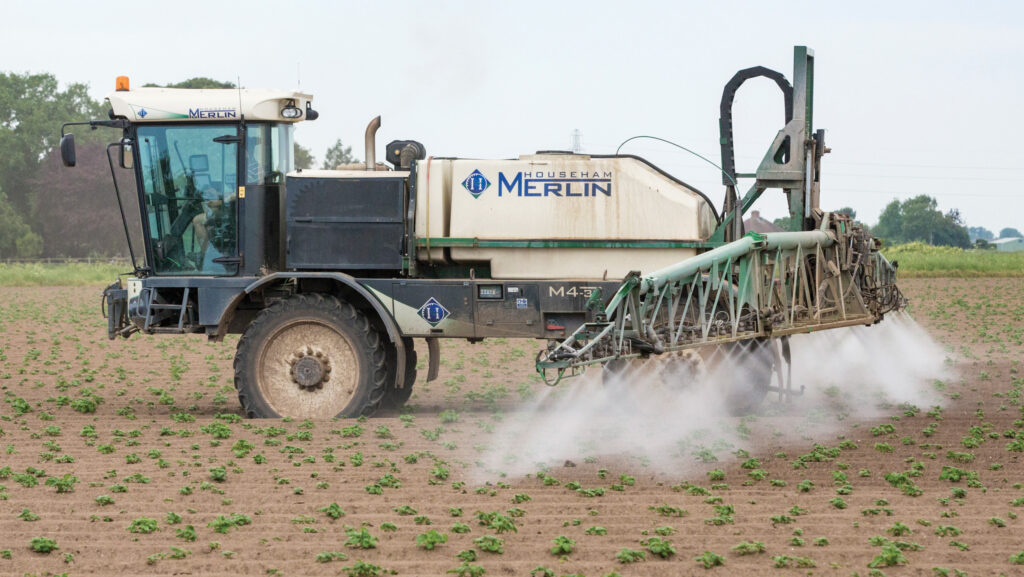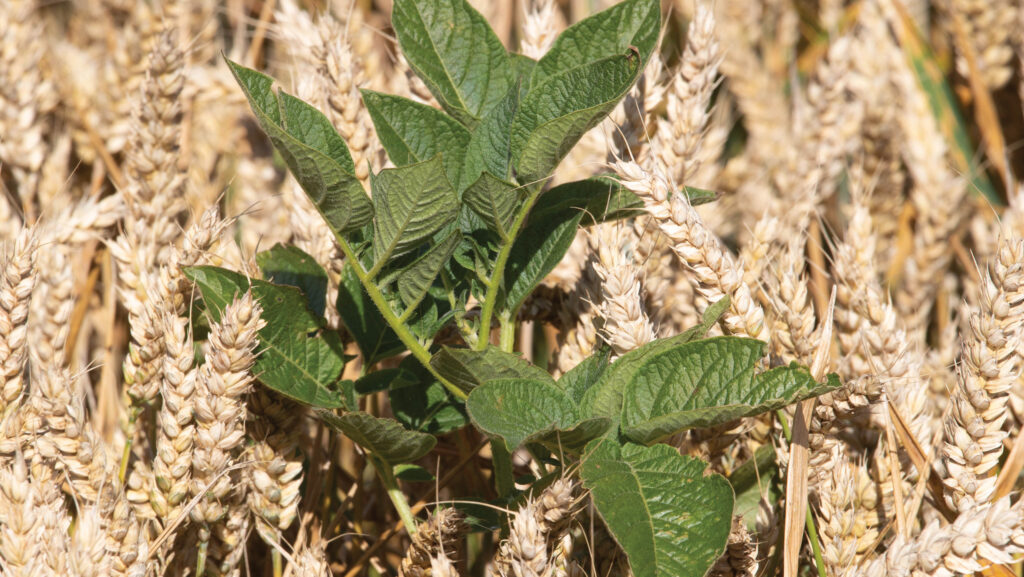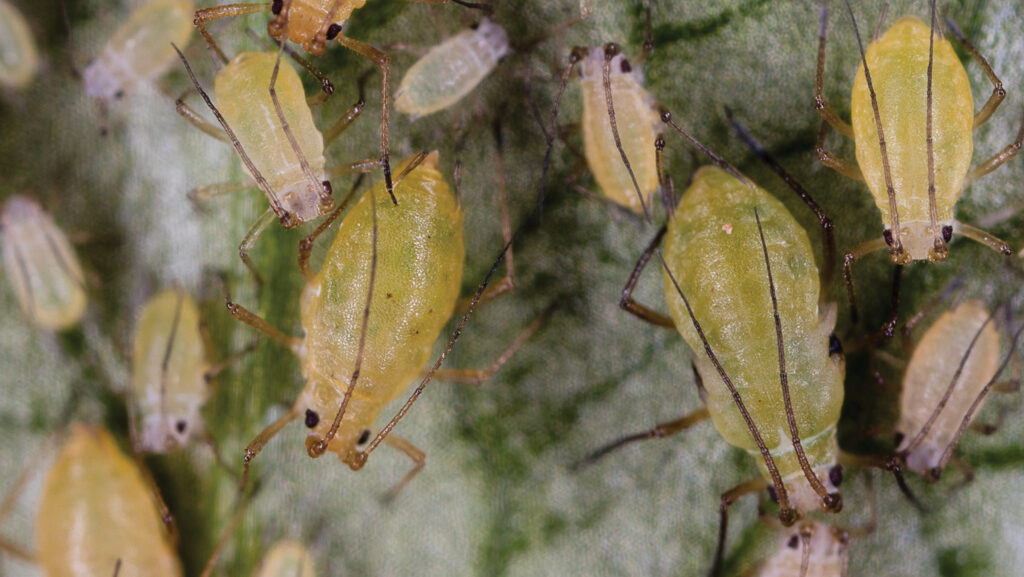Why industry-wide effort is needed to tackle potato virus threat
 @ Blackthorn Arable
@ Blackthorn Arable Across Europe, a recent rise in seed potato crops being downgraded due to virus diseases sends a very strong message that action must be taken now to arrest the upward trend.
This means a shift in focus from individual control measures to a functioning, evidence-based integrated pest management (IPM) strategy that has the confidence of growers.
See also: Are no-till potatoes a pipe-dream?
Viruses that damage potato crops – mostly spread by aphid vectors – are not new, with widespread leaf “curl” documented in agricultural literature as early as the 1700s.
In a modern context, the potato industry has managed the issue effectively in recent decades, with the Seed Potato Classification Scheme (SPCS) having strict virus tolerances in certified seed.
This has been aided by Scotland’s cool climate, which helps produce high-grade stocks relatively free of disease that feed into seed multiplication and ware crops elsewhere.
A range of highly effective insecticides to manage aphid virus vectors have also been available, suppressing transmission of the most harmful persistent and non-persistent viruses.
Upward trend
In Scotland, the SPCS is run by Sasa (Science and Advice for Scottish Agriculture) and its data from the past two seasons shows a sharp upward trend in crops downgraded or failed due to virus.
In 2022, 6% of crop area entered into SPCS was downgraded and 0.3% failed because potato virus Y (PVY) and/or potato leaf roll virus (PLRV) were present at inspection.
By 2023, Sasa data shows a significant jump to 15.4% downgraded and 1.8% failed, notes SAC Consulting’s Aberdeenshire-based potato specialist Kyran Maloney.
In these crops, PLRV was found in a majority of downgrade cases. Until recently, variants of PVY have been of greatest concern, but the persistently transmitted PLRV has made a rapid comeback.
“This shows the trajectory that we’re on and is a really strong indication that action needs to be taken now. The industry needs to come together and deal with it,” he says.
Although the figures are alarming, Kyran stresses that Scottish potato seed remains very high health and the increase shows the SPCS system is functioning as it should.
He adds that the scheme has very strict tolerances, with a single plant enough to result in a downgrade or failure, so it shows the system is doing the job that it was designed to do.
“But that doesn’t mean things can’t be improved and there is an argument to tighten tolerances further and target weak practice with better support.
“Anything that can be done to reduce field generations and move infected stocks out of areas where high-grade seed is produced will also help,” says Kyran.
Climate challenge
When it comes to managing virus, he reminds us of how much of a challenge it is agronomically, particularly as milder winters become the norm, aiding winter pest survival.
Hotter summers then help aphids invade crops earlier when they are most vulnerable, and produce generations of young which build to damaging numbers much faster.
In 2022, suction trap data from Edinburgh and Dundee showed the peach-potato aphid did indeed fly much earlier and in far greater numbers than the 35-year mean, so vector pressure was extreme.
This is behind the significant increase in downgrades and failures in 2023.
“Virus can be transmitted incredibly fast, particularly non-persistent viruses such as PVY, and when tolerances are so low, it is a particularly difficult crop protection problem to solve.
“Our view at SAC Consulting is that there’s too much focus on individual control measures and as an industry we need to build a proper IPM strategy that is backed by evidence and a better understanding of vectors and viruses,” says Kyran.
Yorkshire-based potato specialist John Sarup says preventing or avoiding sources of infection is top of his list as the basis of a long-term virus reduction strategy, with a particular focus on volunteer or groundkeeper control.
This would not only help drain the virus reservoir on a landscape scale, but also reduce pressure from potato cyst nematode (PCN), late blight, soil borne pathogens such as black dot and Rhizoctonia solani, and tobacco rattle virus (spraing) spread by free-living nematodes.
There is a concern that no one is taking responsibility for controlling volunteers across crop rotations – particularly suppliers of rented potato land. This could get worse as more cover crops and Sustainable Farming Incentive (SFI) options are grown.
In these situations, volunteers will thrive unabated, as no herbicides can be used.
He believes legislation could be necessary to ensure volunteers are adequately controlled, particularly in seed producing areas like Scotland and Yorkshire.
“It won’t necessarily sit well with regenerative farming practices or SFI, but we need to decide whether we want a vibrant, high health seed potato industry or not,” adds John.

©Tim Scrivener
Better grower communication
Also key to virus control is proximity of seed crops to dumps, or poor-health ware crops.
The latter can be grown from older seed carrying a higher viral load and are often not afforded the same level of protection with control measures during the growing season.
With ware production likely to continue in seed producing areas, Kyran believes better communication between growers should be a focus.
This can help minimise risk of transmission into seed crops through improved planning and site selection.
“Improving the skills of roguers and ensuring they are taking out infected plants from seed crops is increasingly important, too,” he adds.
Other considerations include varietal propensity, which is a measure of how likely a variety picks up viral infection compared with the “average” Scottish seed crop.
This information is published on Sasa’s website and high propensity varieties should be targeted with additional control measures.
But perhaps more pressing is the thorny issue of dual-purpose crops, where a seed producer will grow a crop on as far as possible, taking a seed fraction out of the harvested tubers and selling oversize into the ware market.
This affects virus control in two ways. First, longer crop duration increases exposure to vectors and potential virus transmission, and second, the rules on use of several aphicides are more restrictive in ware compared with seed.
This encourages risky behaviour, with growers either not protecting a crop adequately as seed or applying products over and above what is legally permitted if selling for ware, risking residue breaches.
Kyran says industry structure and seed production economics encourage dual purpose crops, so growers are not entirely to blame.
“Almost all advisers are trying to steer people away from them, as we don’t think it’s sustainable for the seed industry.
“But we need to support growers better with this, particularly in areas with poorer virus health.
“That means more effective communication of what successful IPM programmes should look like through initiatives like the six steps.” See below.
Virus management in seed
The six steps to effective virus management in certified and home-saved seed:
- Seed and isolation – use clean input stocks and isolate high-grade seed away from infection sources and vector pressure
- Virus removal – rogue crops soon after emergence and throughout the season, and remove groundkeepers from seed and surrounding crops
- Understand varieties and virus interactions – target high risk varieties with additional control measures through the season
- Use decision support systems – suction and yellow water trap data and regular crop inspection improves decision making
- Target spray programmes – spray as soon as aphids are active, utilise early and frequent mineral oil applications, reduce reliance on pyrethroids, and use all translaminar insecticides for effective PLRV control
- Manage crops until haulm is dead – burn down early and maintain spray programmes until haulm is dead. Prevent regrowth until harvest.
Source: Scottish Aphid Borne Virus Working Party
Barriers to IPM adoption
Research into Scottish seed grower attitudes conducted by SRUC and funded by Scotland’s Plant Health Centre, shed light on barriers to successful IPM adoption.
It revealed some apathy towards cultural measures, such as encouraging natural predators with flower strips, straw mulches, mesh covers and purge strips.
Purge strips are established around seed crops and designed to clean the stylets (needle-like projections used to penetrate plant tissue) of migratory aphids of non-persistent viruses such as PVY before they have chance to enter the crop.
Mineral oil adjuvants can be applied as part of a spray programme, including insecticides, and these have proved effective at reducing non-persistent virus in seed in the UK and abroad.
However, a lack of confidence in mineral oils was revealed by the survey.
Growers cited practical constraints and lack of evidence as key reasons for not using mineral oils and the host of other IPM measures outlined.
In a separate exercise, SAC Consulting carried out analysis of Sasa pesticide usage data and found that Scottish seed producers are relying heavily on pyrethroid insecticides and not taking full advantage of translaminar insecticide products.
Certis Belchim’s technical manager James Cheesman says this overreliance on pyrethroids is a concern, with some key aphid virus vectors resistant to the insecticide group, which includes actives like lambda-cyhalothrin and esfenvalerate.
For the persistent PLRV, which is transmitted by colonising aphids like Myzus persicae, it is also a worry that the full allocation of translaminar insecticides is not being used, as they remain effective.

© Blackthorn Arable
Plan programmes
He says the key to building an effective programme is planning.
This should incorporate all the tools in the box and decision support systems such as the suction trap and yellow water trap networks used to flex decisions on product and timing as the season plays out.
For PVY control, mineral oils should be applied routinely from 30% emergence up to tuber initiation – as per current product labels – and pyrethroids used only when aphid species present are susceptible.
“Early oil use takes the pressure off early product choice and translaminar use should commence as soon as colonising aphids are reported locally,” adds James.
John advises on seed crops in Yorkshire, a production area accustomed to dealing with high aphid pressure, and he follows a similar framework, kicking off programmes with mineral oil applications.
He says Yorkshire growers have been successful at suppressing levels of PVY using oils, with no qualms about using them from 30% emergence and at three-day intervals if vector pressure dictates.
This is despite concerns about prolonged leaf wetness increasing late blight risk and the potential for phytotoxicity, which can mask virus symptoms from roguers and inspectors throughout the growing season.
“If you are applying an effective blight programme, there should be adequate protection against disease anyway.
“I tend to recommend oils at slightly lower rates than used on the Continent and don’t see any significant phytotoxic effect.
“You just need to avoid spraying on a hot and sunny day and mixing oil with certain late blight fungicides, such as fluazinam and famoxadone,” he adds.
Colonising aphids
Translaminar programmes usually commence at 100% emergence of the crop and continue throughout the growing season, when colonising aphids are flying.
John tends to use a Teppeki-InSyst-Teppeki-InSyst sequence on 14-day intervals between products, with Movento deployed as a last resort – due to its higher cost – later on, and if the season dictates.
He notes that InSyst should not be applied after 31 July and applications of Movento in flowering potato varieties can only be made from the end of flowering (BBCH 69).
The key virus threats to British potato production |
||||
|
Virus |
Mode of transmission |
Key vectors |
Chemical controls |
Cultural controls |
|
PVY |
Non-persistent – can be acquired by aphids in less than a minute |
Peach-potato aphid* Adult forms of grain aphid*, bird-cherry oat aphid, rose-grain aphid, black-bean aphid, willow-carrot aphid* |
Pyrethroid insecticides (subject to resistance status of aphid vector species) Translaminar insecticides (limited effect) Mineral oils |
Clean input stocks Site selection/crop isolation Virus source removal – rogueing and volunteer control Varieties – avoid or take extra care with more susceptible types Encouraging beneficial insects Straw mulches Physical barriers like mesh or gauze covers Cereal purge strips** Early burndown – reduce exposure to aphid vectors Control regrowth – avoid late season transmission after SPCS inspections |
|
Does not persist on feeding mouth parts (stylet) and within mid-gut of aphid |
||||
|
PLRV |
Persistent – a minimum of 10-20min of feeding on infected plant is required for acquisition of virus |
Peach-potato aphid*, potato aphid, glasshouse-potato aphid, buckthorn-potato aphid, bulb and potato aphid |
Translaminar insecticides |
|
|
Persists in the mid-gut of the aphid for its entire life and is transferred into plants when feeding |
||||
|
*Resistant to pyrethroids widespread or known to occur **Non-persistent virus only |
||||
Active substances
- InSyst acetamiprid
- Teppeki flonicamid
- Movento spirotetramat

